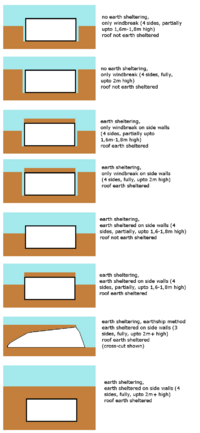
Earth sheltering and windbreaks can also reduce the absolute amount of heat needed by a building. Several feet below the earth, temperature ranges from 4°Celsius in North Dakota to 26°Celcius,[1] in Southern Florida. Wind breaks reduce the amount of heat carried away from a building.
Types of windbreaks
Windbreaks around a house can exist in the form of hedges, gabions (filled with stones or plant leaves), wattle fences or walls (stone, soil, ...)
Advantages and disadvantages
Earth sheltering can increase the thermal mass of a building. However, in temperate and arctic climates we must make sure that we add a insulation layer. The thickness of this depends on the depth of the soil (see Passive solar house) If no insulation layer is put in these areas, heat will leak out into the soil at times of the year when the earth cools down.
As most heat tends to leak out via the roof (as well as via cracks, see Passive solar house) rather than the side walls, it is best to cover the roof with soil so as to attain maximum efficiency. However, to many people this could have a claustrophobic effect. In these cases, covering the walls upto only 1,6-1,8m allows a window to be put in so that (when standing up), this claustrophobic effect can be eliminated. Besides this method, it is also possible to cover the walls entirely, but implement a glass, flat roof.
Hedges made from plants that are not only thickly vegetated but also thorny can deny access to a space behind the plants. See Integrated pest management and Perimeter Crop Protection.
References
See also
External links
- ↑ Stephens, ibid.